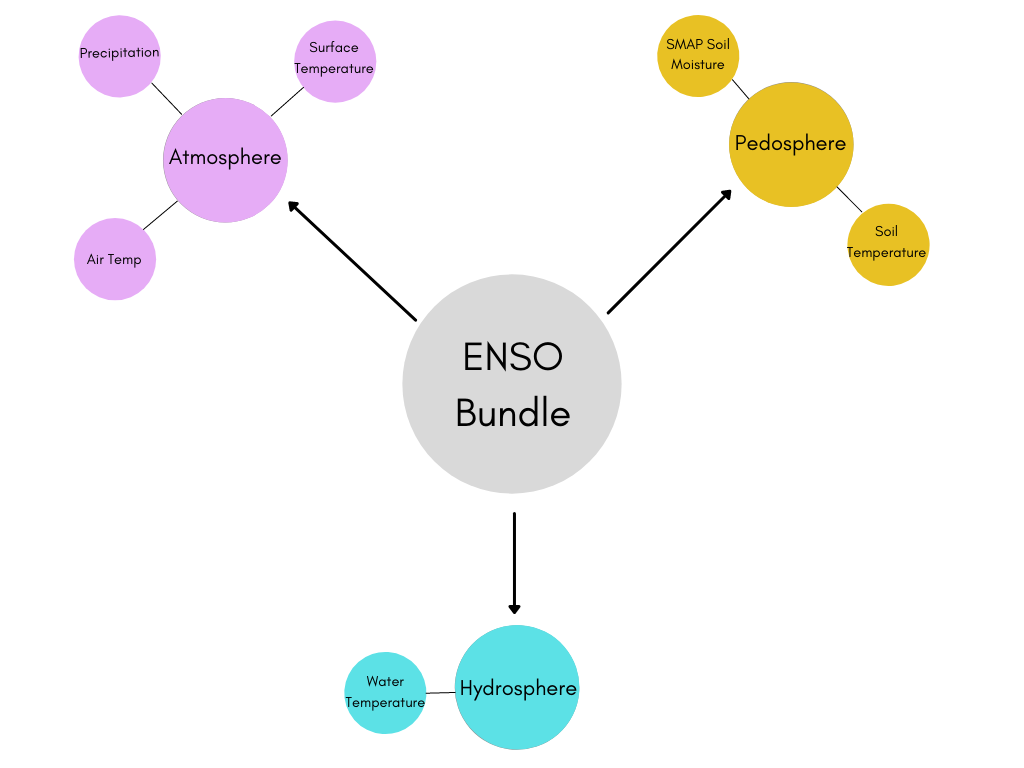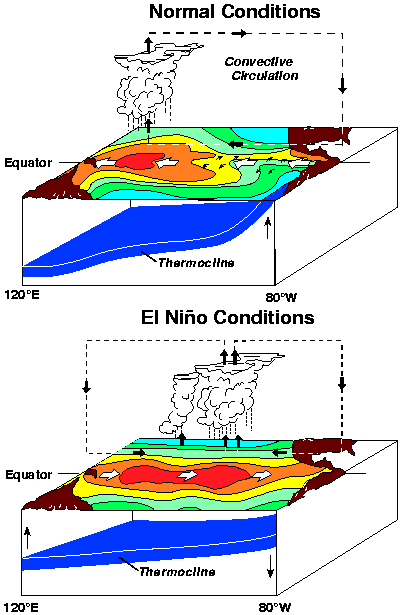ENSO Bundle - Earth as a System
ENSO Protocol Bundle
The El Niño Southern Oscillation (ENSO) is an important climatic phenomenon that can impact weather around the world. Both El Niño and La Niña can significantly influence changes in seasonal weather as well as exacerbate extreme climate events like flooding and droughts.
These interactions around the world are called teleconnections. By studying these teleconnections through the ENSO Protocol Bundle and the ENSO page on Climate.gov, we can develop a more complete understanding of how El Niño affects different locales while engaging students in the weather patterns and anomalies of their local environment.
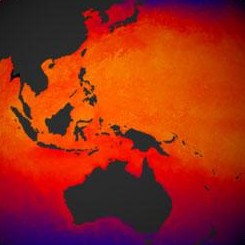
Bundle Overview
- Atmosphere
- Precipitation
- The amount, type, and time of year when precipitation falls in a particular area helps to define the climate of that region. These typical weather patterns can be significantly altered by ENSO and may lead to increased or reduced precipitation at different times of the year.
- Surface Temperature
- The temperature of the the Earth's surface significantly influences the temperature of the atmosphere, and vice versa. The ENSO phenomenon can disrupt this relationship via significant weather events, either cooling or warming the Earth's surface temperature beyond its typical range.
- Air Temperature
- The temperature of the air influences many of its different qualities, like relative humidity, pollutant content, and cloud cover among others. By either raising or lowering the Earth's atmospheric air temperature, ENSO can incite a broad range of affects on local climates around the world.
- Precipitation
- Pedosphere (Soil)
- SMAP Soil Moisture
- Through the effects of the ENSO phenomenon, abnormal levels of precipitation may fall in various habitats around the globe. This has a significant affect on the soil's moisture content and structural stability.
- Soil Temperature
- ENSO can either decrease or increase the local temperature of global biomes. This temperature modulation also affects the temperature of the local soil, impacting plant growth, the timing of budburst or leaf fall, the rate of decomposition of organic wastes, and other chemical, physical, and biological processes that take place in the soil.
- SMAP Soil Moisture
- Hydrosphere
- Water Temperature
- By either warming surface waters or pumping cooler, deeper ones to the surface, ENSO can disrupt the water temperature of various habitats. This disruption has broad-reaching implications for sea-life and the communities that depend on it.
- Water Temperature
El Niño and La Niña are the warm and cool phases of a recurring climate pattern across the tropical Pacific—the El Niño-Southern Oscillation, or “ENSO” for short. The pattern can shift back and forth irregularly every two to seven years, and each phase triggers predictable disruptions of temperature, precipitation, and winds. These changes disrupt the large-scale air movements in the tropics, triggering a cascade of global side effects.
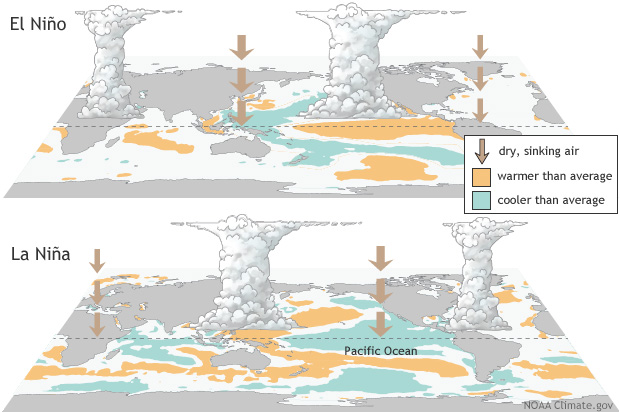
Source: https://www.climate.gov/enso
|
The El Niño/La Niña are shifts in ocean temperature in the Pacific Ocean, shown in the red to blue contours on the surface in the diagram above. The Southern Oscillation is the pressure change between Tahiti and Darwin, Australia, which affects the strength and direction of the winds. Together they are referred to as ENSO. In normal, non-El Niño conditions (top) the trade winds blow to the west along the equator from South America towards Asia in the tropical Pacific Ocean. These winds pile up warm surface water off Asia, so that the sea surface is about 1/2 meter (1 1/2 feet) higher at Indonesia than at Ecuador in South America.
|
The El Niño phenomenon can have an impact on weather conditions around the globe, for both the winter and summer periods, as seen in the maps below. The key shows which areas will be wetter, drier, warmer and cooler than normal.
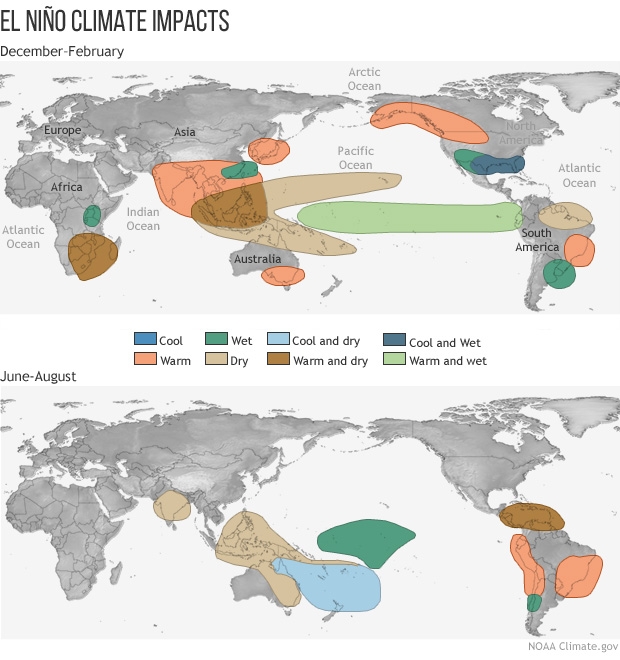
Before taking measurements out in your local community, it's beneficial to first focus your approach by creating research questions. A few examples of these questions include:
- What is the quality of the water in our environment?
- Is my water safe to drink?
- Is my water safe to swim or bathe in?
- Is my water safe to water crops and plants?
- What impact does water, both above and below ground, have on our environment?
- If we have a large rain event, will it flood?
- Can we grow crops in our soil now?
- Is my area prone to erosion and landslides?
- How does water in our environment impact living organisms?
- Is my environment prone to vector-borne disease?
- Is my environment a coastal or inland environment?
- How has water availability been affected by human habitation in my environment?
It got hot, it rained, and puddled the ground! The ENSO weather phenomena influence in mosquitos’ positivity in Rio’s summer
Students: Minas Gerais School Science Club: Juliana Karina Villela, Andrea Silva, Camille Santos, Luís Eduardo Cordeiro de Freitas
Organization/GLOBE School: Escola Minas Gerais, Brazil
Grade Level: Middle School (grades 6-8, ages 11-14)
GLOBE Teacher: INES MARIA MAUAD
Contributors: Brazilian Space Agency - Aline Velloso and Erick Luiz Silva
Original Report
1. Introduction, research questions and hypotheses
Locations around the world are seeing increase in air temperature and rainfall due to extreme weather events related to ENSO. Other issues like climate change, urbanization, and human behaviors have seemed to increase the appearance of mosquito species in populated areas. The results of this study were compiled through data collected by larvae in traps in the school perimeter and official data from the City of Rio de Janeiro. After the data research period, there was a comparative analysis of the data collected with the climatic factors when there is an increase in diseases transmitted by mosquitoes of the Aedes genus, such as - Dengue, Yellow Fever, Chikungunya and Zika.
Research Question
Are the variation in rainfall and temperature distribution, such as those that occur in ENSO phenomena (abnormal warming of surface waters in the Pacific Ocean) factors that influence the reproduction and proliferation of mosquito breeding sites in Rio de Janeiro's summers?
Research Hypothesis
ENSO climate phenomena, which cause variation in temperature and precipitation, affect the proliferation of disease-transmitting mosquitoes, such as Aedes aegypti, in the city of Rio de Janeiro, with impacts on the health of the population, as was seen in the summer from 2015-2016, period of the strongest cycles of the El Niño climate phenomenon. However, in moderate La Niña season observed in 2017 – 2018, there were no impact in the mosquito breeding sites distribution.
Materials and Methods
Study Area
The study area focused on the two locations in Rio de Janeiro County, RJ/ Brazil. (Figure 1)
Figure 1: Urca and Humaíta Rio de Janeiro city, RJ/ Brazil – Research area
Materials
- Traps (transparent 1,5 L PET bottle traps filled with fish food) for mosquito larvae.
- Monthly data from Mosquito Habitat Mapper app.
- GLOBE platform and official data from the City of Rio de Janeiro.
- Monthly data on rainfall (mm) and temperature (°C) collected in the Alerta Rio system and school gauges.
- GLOBE Collection Kit for field capture and data tabs elaborated by students according to GLOBE data platform and Official data.
Figure 2: Science club students analyzing mosquito data
Research Methods
The data collection research used data that was collected from the experiment carried out in two different places in the Minas Gerais School and meeting place of the Science Club, in the city of Rio de Janeiro, where traps were installed to capture the Aedes aegypti mosquito, whose female is the main transmitter of the diseases: Dengue, Chikungunya and Zika – and precipitation and temperature data were collected from 2015 to 2018.
These traps were monitored once a month. The net of traps was installed to cover the entire length of the school and science club area. The temperature and precipitation data were collected in every 5 days, but the research used monthly data.
Mosquito Habitat application, GLOBE website and Official data were used for data visualization and tabs, as well as monthly rainfall (mm) and temperature (°C) data collected in the Alerta Rio system and in devices located at the school. After data collection research, an analysis and interpretation of the results were carried out through comparative graphs, spreadsheets, research on sites such as FIOCRUZ, NASA and disease incidence reports at the Municipal Health Department.
The research was conducted in the data collected from December 2015 – Strong El Niño cycle to April 2018 – Moderate La Niña cycle, from our previous projects and stored on the GLOBE data platform. Remembering that zero is always important, as it determines the appearance / return of the mosquito to the studied areas.
3. Results
Data analysis of air temperature, precipitation and mosquito larvae count ratio versus time from December 2015 to April showed that in periods where there is an increase in rainfall and air temperature (data collection in periods of strong El Niño) there is an increase in mosquito proliferation in the collection areas. (Figure 3)
Figure 3: Minas Gerais data collect from 2015 to April 2018 (source: globe.gov)
The data table (Figure 4) shows an increase in the incidence of mosquitoes in the collection of samples from capture traps, mainly from December 2015 to April 2016, in that period a greater amount of rain and highest temperature were observed in Rio.
Data on mosquito larvae collected during the period from December 2015 to April 2018– comparison to Strong El Niño cycle season and moderate La Niña cycle.
Figure 4: Minas Gerais mosquito larvae collected from 2015 to April 2018 (source: globe.gov.)
4. Discussion
The comparative analysis when we cross-checked the data collected from mosquito proliferation with climatic factors, especially in Rio de Janeiro summers, it is noted that in periods of higher temperature associated with increased rainfall, there is an increase in the development of mosquitoes such as Aedes aegypti – the transmitter of diseases, – Dengue, Chikungunya and Zika (El Niño season).
La Niña moderate phenomenon (2017/2018) influences the climate because it promotes abnormal change in atmosphere pressure in the Pacific Ocean, causing its cooling. These masses also make the atmosphere drier. That is, with less humidity in the air, it is difficult to form large clouds that cause rains causing temperature increase, however, only the two factors together cause the proliferation of reproduction of Aedes aegypti mosquito.
5. Conclusion
Climatic phenomena such as El Niño and La Niña (ENSO) alter temperatures and amounts of rainfall in different regions of the country, in the case of the Southeast region of Brazil, there is an increase in temperature and rainfall and end up making the perfect climate for mosquito proliferation. The rains and temperature allow both larvae and adults to develop their functions more quickly, without restrictions on the quantity and quality of food and reproductive resources.
Cases of dengue, a disease transmitted by Aedes aegypti, increases considerably in years of climatic phenomena, and the spreadsheet shows that the mosquito larvae increase in the years 2015 and 2016, season of cycles of the El Niño climatic phenomenon quite accentuated and it was not relevant in La Niña moderate season of 2017/2018.
We can conclude that climate factors, such as increased temperature and precipitation, affect the spread of mosquitoes that transmit diseases, such as Aedes aegypti, in the city of Rio de Janeiro, with impacts on the health of the population.
ENSO is an important part of the global climate system. To accurately determine its effects on your area, you need to collect measurements for several years so that you have local data for at least two phases of the ENSO cycle: El Niño, La Niña, and Normal. With this data set, you can begin to compare ENSO's effects on your average air, surface, soil, and water temperatures, as well as precipitation and soil moisture levels. By studying these measurements, you can learn more about the environmental impacts ENSO has on your local habitat.
Acknowledgements
Compilers:
- Claudia Caro
- Olawale Oluwafemi (Femi)
Editors:
- Dr. Dixon Butler
- Prof. Cartalis
Additional thanks to members of the GLOBE Science Working Group and Brian Campbell for improving the quality of the work.
References
- SCB Economic Intelligence Center. (2018, October). Drought, a worrying situation for Thai agriculture. https://www.scbeic.com/en/detail/product/1429
- http://www.pmel.noaa.gov/tao/elnino/el-nino-story.html
- http://www.pmel.noaa.gov/elnino/impacts-of-el-nino






